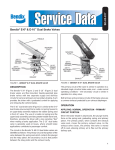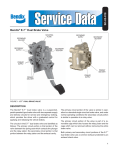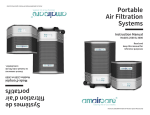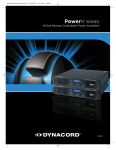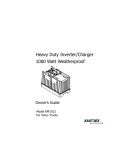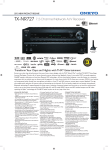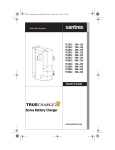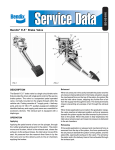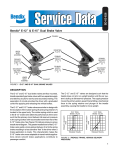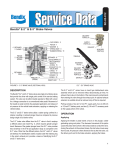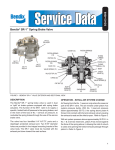Download BENDIX BW2159 User's Manual
Transcript
SD-03-832 ® Bendix® E-10PR™ Retarder Control Brake Valve TREADLE MOUNTING PLATE RETARDER CONTROL SECTION SUPPLY 4 PORTS VALVE ELECTRICAL CONNECTOR DELIVERY 4 PORTS AUXILIARY EXHAUST ™ FIGURE 1 - E-10PR RETARDER CONTROL BRAKE VALVE DESCRIPTION Refer to Figures 3 and 4 for item numbers referenced in parenthesis. The Bendix® E-10PR™ retarder control brake valve is used with retarder systems installed on automatic transmissions. Automatic transmission retarders are used to retard forward motion of the vehicle above 5 mph. Retarders are most popular in the transit (buses/coaches) industry and are used to extend the life of brake system components. The retarder system is actuated early in the brake application, before air pressure is delivered. Retarders can be installed either internally or externally on the automatic transmission and are generally electrically activated by devices such as the E-10PR™ valve. Most retarders redirect the flow of hydraulic fluid through the torque converter while others use a small internal brake in the output section of the transmission. The E-10PR™ valve is capable of controlling up to a threestage retarder (different levels of retardation) through the sequencing of its three electrical switches. The sequencing of these switches is important to the proper operation of the retarder. E-10PR™ retarder control brake valve is a floor mounted, treadle operated type brake valve with two separate supply and delivery circuits for service (primary and secondary) braking, which provides the driver with a graduated control for applying and releasing the vehicle brakes. The E-10PR™ valve uses a metal coil spring (6) housed in an upper body assembly. The use of a metal coil spring (and the upper body assembly) provides greater treadle travel and, therefore, provides the driver with a less sensitive "feel" when making a brake application. The E-10PR™ retarder control brake valve is generally used on buses, where smooth brake applications contribute to passenger comfort. The circuits in the E-10PR™ retarder control brake valves are identified as follows: The No. 1 or primary circuit is that portion of the valve between the spring seat which contacts the plunger and the relay piston; the No. 2 or secondary circuit is that portion between the relay piston and the exhaust cavity. The primary circuit of the valve is similar in operation to a standard single circuit air brake valve and under normal operating conditions the secondary circuit is similar in operation to a relay valve. Both primary and secondary circuits of the brake valve use a common exhaust protected by an exhaust diaphragm. OPERATION - Refer to Figure 2 APPLYING: NORMAL OPERATION - NO. 1 OR PRIMARY CIRCUIT PORTION When the brake treadle is depressed, the plunger exerts force on the spring seat (5), graduating spring (12), and primary piston (11). The primary piston, which contains the exhaust valve seat, closes the primary exhaust valve. As the exhaust valve closes, the primary inlet valve is moved off its seat allowing primary air to flow out the No. 1 or primary delivery port. 1 MV-3™ MANIFOLD VALVE TP-5™ TRACTOR PROTECTION VALVE TRAILER CONTROL VALVE SLACK ADJUSTER SLACK ADJUSTER BRAKE CHAMBER (E-10PR™) RETARDER CONTROL BRAKE VALVE GOVERNOR QUICK RELEASE VALVE DOUBLE CHECK VALVE AIR DRYER COMPRESSOR SPRING BRAKES BP-R1™ BOBTAIL PROPORTIONING VALVE SUPPLY RESERVOIR (WET TANK) #1 SERVICE RESERVOIR #2 SERVICE RESERVOIR FIGURE 2 - TYPICAL PIPING SCHEMATIC TREADLE ROLLER SPRING BOOT 1 5 6 11 13 12 29 30 24 19 FIGURE 3 - E-10PR™ RETARDER CONTROL BRAKE VALVE SECTIONAL VIEW 2 20 APPLYING: NORMAL OPERATION - NO. 2 OR SECONDARY CIRCUIT When the primary inlet valve (29) is moved off its seat, air is permitted to pass through the bleed passage and enters the relay piston cavity. The air pressure moves the relay piston (24), which contains the exhaust seat, and closes the secondary exhaust valve. As the secondary exhaust valve closes, the inlet valve (19) is moved off its seat allowing the secondary air to flow out the delivery of the same circuit. Because of the small volume of air required to move the relay piston (24), action of the secondary circuit of the valve is almost simultaneous with the primary circuit portion. APPLYING: LOSS OF AIR IN THE NO. 2 OR SECONDARY CIRCUIT Should air be lost in the No. 2 or secondary circuit, the No. 1 or primary circuit will continue to function as described above under Normal Operation: No.1 or Primary Circuit Portion. APPLYING: LOSS OF AIR IN THE NO. 1 OR PRIMARY CIRCUIT Should air be lost in the primary circuit, the function will be as follows: As the brake treadle is depressed and no air pressure is present in the primary circuit supply and delivery ports, the primary piston (11) will mechanically move the relay piston (24) , allowing the piston to close the secondary exhaust valve and open the secondary inlet valve and allow air to flow out the secondary delivery port. BALANCED: NO. 1 OR PRIMARY CIRCUIT When the primary delivery pressure acting on the primary piston (11) equals the mechanical force of the brake pedal application, the primary piston (11) will move and the primary inlet valve (29) will close, stopping further flow of air from the primary supply line through the valve. The exhaust valve remains closed preventing any escape of air through the exhaust port. BALANCED: NO. 2 OR SECONDARY CIRCUIT When the air pressure on the delivery side of the relay piston (24) approaches that being delivered on the primary side of the relay piston, the relay piston moves closing the secondary inlet valve and stopping further flow of air from the supply line through the valve. The exhaust remains closed as the secondary delivery pressure balances the primary delivery pressure. When applications in the graduating range are made, a balanced position in the primary circuit is reached as the air pressure on the delivery side of the primary piston (11) equals the effort exerted by the driver's foot on the treadle. A balanced position in the secondary portion is reached when air pressure on the secondary side of the relay piston (24) closely approaches the air pressure on the primary side of the relay piston. When the brake treadle is fully depressed, both the primary and secondary inlet valves remain open and full reservoir pressure is delivered to the actuators. RELEASING: NO. 1 OR PRIMARY CIRCUIT With the brake treadle released, mechanical force is removed from the spring seat (5), graduating spring (6), and primary piston (11). Air pressure and spring load moves the primary piston, opening the primary exhaust valve, allowing air pressure in the primary delivery line to exhaust out the exhaust port. RELEASING: NO. 2 OR SECONDARY CIRCUIT With the brake treadle released, air is exhausted from the primary circuit side of the relay piston (24). Air pressure and spring load move the relay piston, opening the secondary exhaust valve, allowing air pressure in the secondary delivery line to exhaust out the exhaust port. PREVENTIVE MAINTENANCE Important: Review the Bendix Warranty Policy before performing any intrusive maintenance procedures. A warranty may be voided if intrusive maintenance is performed during the warranty period. No two vehicles operate under identical conditions, as a result, maintenance intervals may vary. Experience is a valuable guide in determining the best maintenance interval for air brake system components. At a minimum, the E-10PR™ valve should be inspected every 6 months or 1500 operating hours, whichever comes first, for proper operation. Should the E-10PR™ valve not meet the elements of the operational tests noted in this document, further investigation and service of the valve may be required. Visually check for physical damage to the brake valve such as broken air lines and broken or missing parts. Every 3 months, 25,000 miles, or 900 operating hours: Clean any accumulated dirt, gravel, or foreign material away from the heel of the treadle, plunger boot, and mounting plate. Lubricate the treadle roller, roller pin, and hinge pin, with Barium grease per BW-204-M (Bendix part 246671). Check the rubber plunger boot for cracks, holes or deterioration and replace if necessary. Also, check mounting plate and treadle for integrity. Apply a thin layer of Barium grease, per BW-204-M (Bendix part 246671), between plunger and mounting plate – do not over oil! 3 SERVICE CHECKS OPERATING CHECK Check the delivery pressure of both primary and secondary circuits using accurate test gauges. Depress the treadle to several positions between the fully released and fully applied positions, and check the delivered pressure on the test gauges to see that it varies equally and proportionately with the movement of the brake pedal. After a full application is released, the reading on the test gauges should fall off to zero promptly. It should be noted that the primary circuit delivery pressure will be about 2 PSI greater than the secondary circuit delivery pressure with both supply reservoirs at the same pressure. This is normal for this valve. Important: A change in vehicle braking characteristics or a low pressure warning may indicate a malfunction in one or the other brake circuit, and although the vehicle air brake system may continue to function, the vehicle should not be operated until the necessary repairs have been made and both braking circuits, including the pneumatic and mechanical devices, are operating normally. Always check the vehicle brake system for proper operation after performing brake work and before returning the vehicle to service. LEAKAGE CHECK 1. Make and hold a high pressure (80 psi) application. 2. Coat the exhaust port and body of the brake valve with a soap solution. 3. Leakage permitted is a 1” bubble in 3 seconds. If the brake valve does not function as described above or leakage is excessive, it is recommended that it be replaced with a new or remanufactured unit, or repaired with genuine Bendix parts available at authorized Bendix parts outlets. REMOVAL - Refer to figures 3 and 4 for item numbers referenced in parenthesis. 1. Chock the vehicle wheels or park the vehicle by mechanical means. (Block and hold vehicle by means other than air brakes.) Drain all air system reservoirs. REMOVAL OF THE RETARDER CONTROL ASSEMBLY 1. Disconnect the plug of the electrical cable from its mating socket of the vehicles power supply. 2. Identify and disconnect all air supply and delivery lines at the brake valve if brake valve replacement is required. 3. Remove the brake valve and treadle assembly from the vehicle by removing the three cap screws on the outer bolt circle of the mounting plate. NOTE: Before removing the treadle assembly, be sure to mark the position of the treadle mounting plate relative to the retarder control assembly. 4 4. Remove the treadle from the mounting plate by tapping out the roll pin and then the pin retaining the treadle, spring and mounting plate. NOTE: Mark the position of the retarder control assembly to the upper valve housing. 5. Remove the boot from the plunger. 6. Remove the three remaining cap screws (2) from the mounting plate. Separate the mounting plate from the retarder control section (1) and the retarder control section from the upper valve housing (13). CAUTION: Do Not separate the upper valve housing from the balance of the brake valve. Keep the plunger in the retarder control section in its bore. Switch damage will result from attempted removal or permitting it to slide out of the body/bore by more than 3/8”. DISASSEMBLY - Refer to figures 3 and 4 for item numbers referenced in parenthesis. 1. If the entire brake valve and treadle assembly was removed from the vehicle, remove the three cap screws securing the treadle assembly to the basic brake valve. 2. Remove the screw (15) securing the exhaust diaphragm (17) and washer (16) to the exhaust cover (18). 3. Remove the four screws that secure the exhaust cover (18) to the lower body. 4. Remove the secondary inlet and exhaust valve assembly (19) from the lower body. 5. Remove the four hex head cap screws securing the lower body to the upper body and separate the body halves. 6. Remove the rubber seal ring (21) from the lower body. 7. While depressing spring seat (5), remove retaining ring (4). Remove spring seat (5) and coil spring (6). Caution: Before proceeding with the disassembly, refer to Figures 3 and 4 and note that the lock nut (7) and stem (22) are used to contain the primary piston return spring (12), stem spring (9), and the relay piston spring (27). The combined force of these springs is approximately 50 pounds and care must be taken when removing the lock nut as the spring forces will be released. It is recommended that the primary piston and relay piston be manually or mechanically contained while the nut and stem are being removed. 8. Using a 3/8” wrench, hold the lock nut (7) on the threaded end of the stem (22). Insert a screwdriver to restrain the stem, remove the lock nut (7), spring seat, (8) and stem spring (9). 9. Remove adapter (13) and o-ring (14). Remove the primary piston (11) from adapter (13) and o-ring (10) from the primary piston (11). 10. Remove the relay piston (24), relay piston spring (27), primary piston (11) and primary piston return spring (12) from the upper body. Use care so as not to nick seats. 2 1 3 30 4 5 29 6 28 7 27 8 26 9 25 10 24 11 23 22 12 21 13 20 14 19 18 17 16 15 FIGURE 4 - E-10PR™ RETARDER CONTROL BRAKE VALVE - EXPLODED VIEW 5 11. A small washer (26) will be found in the cavity of the lower side of the primary piston (11). 12. Remove the large and small o-rings (23 & 25) from the relay piston (24). 13. Remove the retaining ring (28) securing the primary inlet and exhaust valve assembly (29) in the upper body and remove the valve assembly. CLEANING AND INSPECTION 8. Compress the primary and relay pistons (11 & 24) and retaining ring into the upper body from either side and hold compressed, either manually or mechanically. See the cautionary note under step 7 in the Disassembly section of this manual. 9. Place the stem spring (9), the spring seat (8) (concave side up) and lock nut (7) on the stem (22). Torque to 20 - 30 inch pounds. 1. Wash all metal parts in mineral spirits and dry. 10. Install coil spring (6), spring seat (5), and retaining ring (4) . 2. Inspect all parts for excessive wear or deterioration. 11. Replace the rubber seal ring (21) on the lower body. 3. Inspect the valve seats for nicks or burrs. 12. Install the 4 hex head cap screws securing the lower body to the upper body. Torque to 30 - 60 inch pounds. 4. Check the springs for cracks or corrosion. 5. Replace all rubber parts and any part not found to be serviceable during inspection, use only genuine Bendix replacement parts. ASSEMBLY Prior to reassembling, lubricate all o-rings, o-ring grooves, piston bores, and metal to metal moving surfaces with Dow Corning 55 o-ring lubricant (Bendix piece number 291126). Note: All torques specified in this manual are assembly torques and can be expected to fall off, after assembly is accomplished. Do not retorque after initial assembly torques fall. 1. Install the primary inlet and exhaust assembly (29) in the upper body and replace the retaining ring (28) to secure it. Be sure the retaining ring is seated completely in its groove. 2. Install the large and small o-rings (23 & 25) on the relay piston (24). 3. Place relay piston spring (27) in concave portion of relay piston (24) and install relay piston through primary inlet/ exhaust assembly (29) into under side of upper body. 4. Install o-ring (14) on adapter (13) and install adapter on upper body. Install o-ring (10) on primary piston (11). 5. Place screwdriver, blade up, in vise. Insert stem (22) through the relay piston upper body sub assembly, slide this assembly over the blade of the secured screwdriver, engage the screwdriver blade in the slot in the head of the stem. 6. Place the washer (26) over the stem (22) and on top of the relay piston (24). 7. Install primary return spring (12) in upper body piston bore. 6 13. Install the secondary inlet and exhaust valve assembly (19) on the lower body. 14. Install the screws that secure the exhaust cover (18) to the lower body. Torque to 20 - 40 inch pounds. 15. Secure the screw (15) holding the exhaust diaphragm (17) and the diaphragm washer (16) to the exhaust cover (18). Torque to 5 - 10 inch pounds. INSTALLATION OF THE RETARDER CONTROL ASSEMBLY 1. Place the retarder control assembly (1) onto the upper valve housing (13) making sure it is oriented correctly. (Refer to marks made on unit prior to disassembly). CAUTION: Switch damage will result if the plunger is permitted to slide out of the bore by more than 3/8”. Place the mounting bracket onto the top of the retarder control assembly in its proper location. (Again referring to marks made prior to disassembly.) Retain with the three long cap screws (2) and torque to 80-120 in. lbs. Do not use silicone grease in the retarder control section. 2. Replace the boot by expanding its large diameter into the recess in the mounting plate and the small diameter into the recess of the plunger. 3. Connect all air supply and delivery lines to the brake valve that were previously removed. 4. Plug the connector of the cable assembly into its mating component from the vehicles power supply. Switch adjustment will be required if the brake valve or retarder control has been replaced. 5. Replace the treadle assembly onto the valve. Place the yellow end of the spring into the hole provided in the mounting plate. Catch the opposite end of the spring under the treadle and hold the treadle in place while installing the pin through the ears of the mounting plate and the I.D. of the spring. Install the roll pin into its hole in the bushing on one side of the treadle making sure it enters its mating hold in the pin of the treadle assembly. CALIBRATION OF MICRO SWITCHES ON ALL TREADLE ACTUATED BRAKE VALVES (Except the lever actuated model) See Figure 5. VALVE INSTALLATION 1. Install the assembled brake valve on the vehicle. 2. Reconnect all air lines to the valve using the identification made during VALVE REMOVAL step 1. NOTE: Cannon connector pins are identified with numbers and Packard connector pins are identified with letters. 3. After installing the brake valve assembly, perform the “OPERATION AND LEAKAGE CHECKS” before placing the vehicle in service. 1. Remove the two Phillips screws and remove the cover of the switch plate, exposing the switch plate. 2. Unplug the power cable at the quick connect connector. RETARDER BRAKE VALVE ADJUSTMENT PROCEDURE 3. To adjust switch #1, connect the black lead of the voltohm meter to pin #3 or C of the connector and the red lead to pin #1 or A of the connector. At this time there should be a maximum reading on the meter (open circuit). Slowly start to depress the treadle. After approximately 1/4" movement at the end of the treadle, switch #1 should close and the volt-ohm meter will respond with a reading of near 0 (closed circuit). Equipment required to perform adjustments: Qty. 1 1 1 1 Description Air Gauge Phillips Screw Driver 0.050 Allen Wrench Volt-Ohm Meter SWITCH ADJUSTMENTS 4. To check switch #2, leave the black lead of the volt-ohm meter connected to pin #3 or C of the connector; connect the red lead to pin #4 or D. At this time, the meter will have a maximum reading (open circuit). Slowly depress the treadle until you can feel resistance to the movement being applied. At the point of the end of the free travel of the treadle, approximately 1/2" movement at the end of the treadle, switch #2 should close and the volt-ohm will respond with a reading of near 0. If an adjustment to this switch is required, follow the instructions under the heading “Switch Adjustments.” Adjustments to the closing of the switches can be attained by inserting a 0.050 Allen screw, turning the screw clockwise to decrease the amount of movement required to close the switch and counterclockwise to increase the amount of movement required to close the switch. All adjustments of the switches and readings of the volt-ohm meter are to be made with the treadle being depressed (downward stroke). Never attempt to adjust the switches on the release of the treadle application (upward stroke). COURSE VERTICAL ADJUSTMENT (SEQUENCE) LATERAL ADJUSTER SCREWS (FINE ADJUSTMENT OF SWITCH ARM TRAVEL) CANNON STYLE CONNECTOR (NUMBERED) PACKARD STYLE CONNECTOR (LETTERS) PACKARD STYLE CONNECTOR CANNON STYLE CONNECTOR FIGURE 5 - RETARDER BRAKE VALVE SWITCH ADJUSTMENT 7 5. To check switch #3, continue to have the black lead of the volt-ohm meter connected to pin #3 or C of the connector and connect the red lead to pin #2 or B. Install an air gauge in the primary delivery circuit. With the treadle in the retracted position, the reading on the voltohm meter will be maximum (open circuit). Slowly depress the treadle until the air delivery of the primary circuit (shown on the air gauge) reaches 12 psi. At which time switch #3 should close and the volt-ohm meter will respond with a reading of near 0. If an adjustment to this switch is required, follow the instructions under the heading “Switch Adjustments.” 6. When all adjustments to the switches are complete, the Allen screws should be resealed using any available sealant (such as paint or liquid gasket material). 7. Replace the cover and gasket on the switch plate and retain by installing the two Phillips screws and tightening securely. WARNING! PLEASE READ AND FOLLOW THESE INSTRUCTIONS TO AVOID PERSONAL INJURY OR DEATH: When working on or around a vehicle, the following general precautions should be observed at all times. 1. Park the vehicle on a level surface, apply the parking brakes, and always block the wheels. Always wear safety glasses. 2. Stop the engine and remove ignition key when working under or around the vehicle. When working in the engine compartment, the engine should be shut off and the ignition key should be removed. Where circumstances require that the engine be in operation, EXTREME CAUTION should be used to prevent personal injury resulting from contact with moving, rotating, leaking, heated or electrically charged components. 8 3. Do not attempt to install, remove, disassemble or assemble a component until you have read and thoroughly understand the recommended procedures. Use only the proper tools and observe all precautions pertaining to use of those tools. 4. If the work is being performed on the vehicle’s air brake system, or any auxiliary pressurized air systems, make certain to drain the air pressure from all reservoirs before beginning ANY work on the vehicle. If the vehicle is equipped with an AD-IS™ air dryer system or a dryer reservoir module, be sure to drain the purge reservoir. 5. Following the vehicle manufacturer’s recommended procedures, deactivate the electrical system in a manner that safely removes all electrical power from the vehicle. 6. Never exceed manufacturer’s recommended pressures. 7. Never connect or disconnect a hose or line containing pressure; it may whip. Never remove a component or plug unless you are certain all system pressure has been depleted. 8. Use only genuine Bendix ® replacement parts, components and kits. Replacement hardware, tubing, hose, fittings, etc. must be of equivalent size, type and strength as original equipment and be designed specifically for such applications and systems. 9. Components with stripped threads or damaged parts should be replaced rather than repaired. Do not attempt repairs requiring machining or welding unless specifically stated and approved by the vehicle and component manufacturer. 10. Prior to returning the vehicle to service, make certain all components and systems are restored to their proper operating condition. BW2159 © 2004 Bendix Commercial Vehicle Systems LLC. All rights reserved. 3/2004 Printed in U.S.A.











